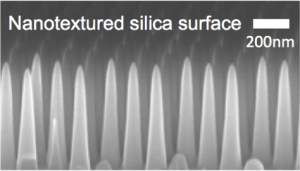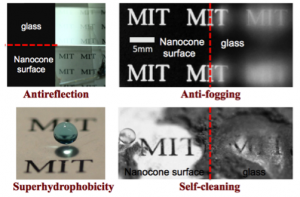Nanotextured Silica Surfaces with Robust Superhydrophobicity and Omnidirectional Broadband Supertransmissivity
- Category: Nanotechnology
- Tags: george barbastathis, hyungryul choi
Natural biological surfaces have evolved to optimize their physicochemical properties and structures at the micro/nanoscale for a wide variety of functions, ranging from wettability to optical properties [1] [2] [3] . Microscopic studies of the textured surfaces commonly encountered on living organisms, e.g., lotus leaves, desert beetles, and moth eyes, have revealed complementary roles of material properties and texture on the surface functionalities that have been developed during adaptation to different environments. These studies have in turn inspired biomimetic surfaces emulating the self-cleaning [4] , water harvesting [5] , and anti-reflective [6] capabilities of functional surfaces found in nature.
Taking cues from nature, we use tapered conical nanotextures to fabricate the multifunctional surfaces; the slender conical features result in large topographic roughness while the axial gradient in the effective refractive index minimizes reflection through adiabatic index-matching between air and the substrate. Precise geometric control of the conical shape and slenderness of the features as well as periodicity at the nanoscale are all keys to optimizing the multi-functionality of the textured surface, but at the same time these demands pose the toughest fabrication challenges.
Here we report a systematic approach to concurrent design of optimal structures in the fluidic and optical domains and a fabrication procedure that achieves the desired aspect ratios, periodicities with few defects, and large pattern area [7] . Our fabricated nanostructures demonstrate structural superhydrophilicity or, in combination with a suitable chemical coating, robust superhydrophobicity. Enhanced polarization-independent optical transmission exceeding 98% has also been achieved over a broad range of bandwidth and incident angles. These nanotextured surfaces are also robustly anti-fogging or self-cleaning, offering potential benefits for applications such as photovoltaic solar cells.
- Figure 1: Cross-sectional SEM micrograph of fabricated high aspect ratio subwavelength nanocone structures [7] .
- Figure 2: Images showing multi-functionality of the fabricated surface: a) anti-reflectivity, b) anti-fogging effect, c) superhydrophobicity, and d) self-cleaning effect [7] .
- W. Barthlott and C. Neinhuis, “Purity of the sacred lotus, or Escape from contamination in biological surfaces,” Planta, vol. 202, no. 1, pp. 1-8, 1997. [↩]
- P. B. Clapham and M. C. Hutley, “Reduction of lens reflection by moth eye principle,” Nature, vol. 244, no. 5414, pp. 281-282, 1973. [↩]
- W. J. Hamilton and M. K. Seely, “Fog basking by the Namib Desert Beetle, Onymacris unguicularis,” Nature, vol. 262, no. 5566, pp. 284-285, 1976. [↩]
- A. Lafuma and D. Quéré, “Superhydrophobic states,” Nature Materials, vol. 2, no. 7, pp. 457-460, 2003. [↩]
- A. R. Parker and C. R. Lawrence, “Water capture by a Desert Beetle,” Nature, vol. 414, no. 6859, pp. 33-34, 2001. [↩]
- Y.-F. Huang, S. Chattopadhyay, Y.-J. Jen, C.-Y. Peng, T.-A. Liu, Y.-K. Hsu, C.-L. Pan, H.-C. Lo, C.-H. Hsu, Y.-H. Chang C.-S. Lee, K.-H. Chen, and L.-C. Chen, “Improved broadband and quasi-omnidirectional anti-reflection properties with biomimetic silicon nanostructures,” Nature Nanotechnology, vol. 2, no. 12, pp.770-774, 2007. [↩]
- K.-C. Park, H. J. Choi, C.-H. Chang, R. E. Cohen, G. H. McKinley, and G. Barbastathis, “Nanotextured silica surfaces with robust super-hydrophobicity and omnidirectional broadband super-transmissivity,” ACS Nano, vol. 6, no. 5, pp.3789-3799, 2012. [↩] [↩] [↩]

